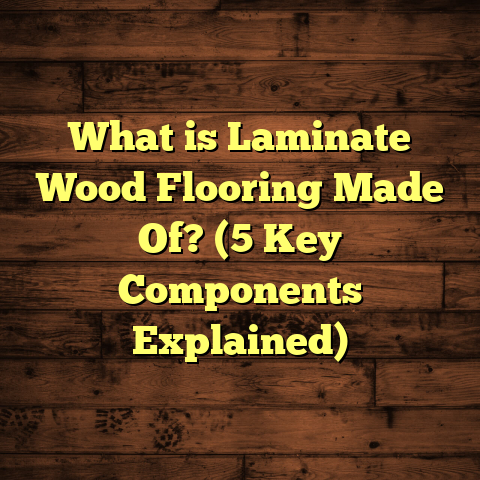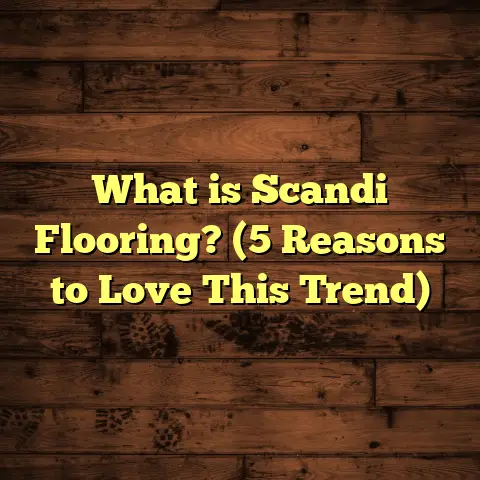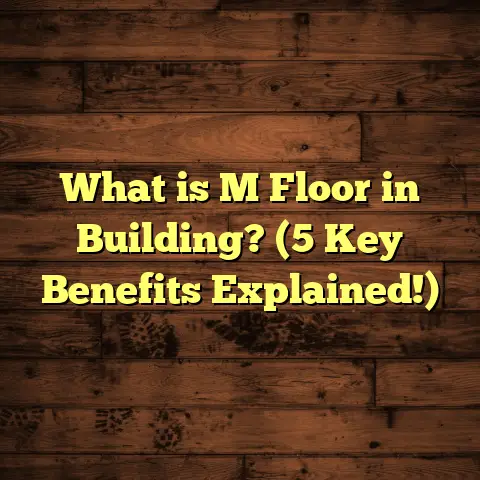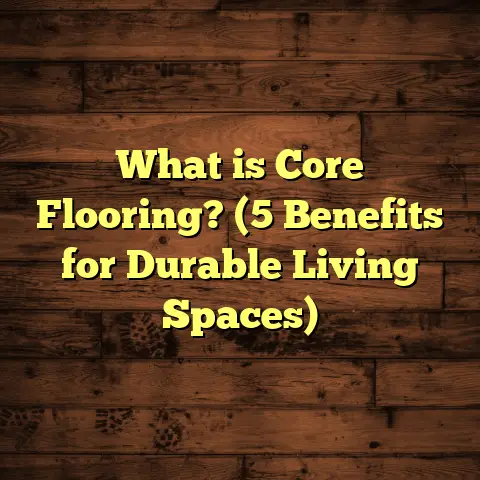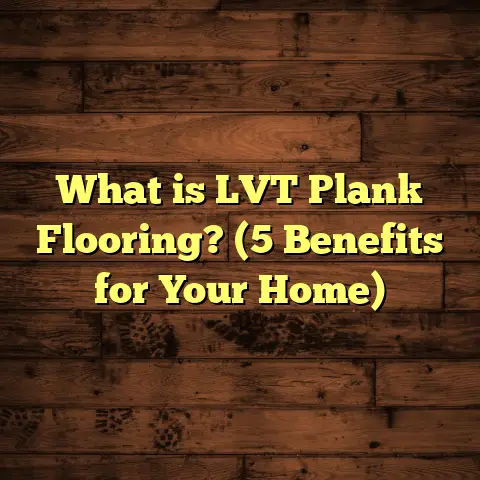What is Dryback Vinyl Flooring? (5 Key Benefits Explained)
What is Dryback Vinyl Flooring?
Did you know vinyl flooring makes up nearly 30% of all residential flooring installations across the U.S.? That’s a huge slice of the market and for good reason. Among the many types of vinyl flooring on offer, dryback vinyl is one that I’ve worked with extensively and has consistently impressed me both professionally and personally. If you’re wondering what exactly dryback vinyl flooring is, you’re in the right place—let me walk you through everything I know about it.
Dryback vinyl flooring refers to vinyl sheets or tiles that are permanently glued—yes, glued—to the subfloor. This distinguishes it from other vinyl floors like loose-lay or click-lock where vinyl planks or tiles float above the subfloor without adhesive. The “dryback” term comes from the fact that the backing of these vinyl sheets or tiles is dry and flat, requiring adhesive application during installation to create a secure bond.
When I first started working with dryback vinyl years ago, I was skeptical. Could glue-down vinyl really match the durability and look of engineered hardwood or stone tiles? Over time, my experience has shown that it can—and often does—outperform many alternatives in terms of longevity, design flexibility, and maintenance ease.
The Manufacturing Process and Technical Details
Understanding how dryback vinyl flooring is made helps explain why it performs so well. Let’s break down what goes into making these products.
Multi-layer Construction
Dryback vinyl sheets are made up of several layers, each serving a unique purpose:
- Backing Layer: Usually made from fiberglass or felt, this layer provides dimensional stability. It helps prevent expansion or contraction due to temperature fluctuations and moisture.
- Vinyl Base Layer: This is a solid vinyl sheet providing thickness and strength.
- Printed Design Layer: Using high-definition digital printing technology, manufacturers apply patterns to mimic natural materials such as wood grains, stone textures, or ceramic tile designs. This layer is responsible for the aesthetic appeal and can be incredibly realistic.
- Wear Layer: A transparent protective coating that shields the printed design from surface damage like scratches, scuffs, stains, and UV fading.
- Optional Coatings: Some products include extra layers for anti-slip properties or enhanced stain resistance.
Thickness and Wear Layers
Thickness varies depending on product grade—residential-grade sheets usually range between 2mm and 3mm thick, while commercial variants can be thicker for added durability. The wear layer is especially important: residential products typically feature wear layers between 12 mil (0.3mm) to 20 mil (0.5mm), with commercial options going up to 28 mil (0.7mm) for heavy traffic areas.
The thickness of the wear layer corresponds directly to how well the floor resists abrasion and impact over time. In my experience, clients who choose thicker wear layers see fewer repairs and replacements down the road.
Adhesive Systems
The adhesive used for dryback vinyl installation is generally a polyurethane-based or water-based glue designed to create a strong bond with different subfloors such as concrete, plywood, or existing flooring.
One critical point I always stress: proper subfloor preparation is non-negotiable. The surface must be completely clean, dry, level within a certain tolerance (usually less than 3/16″ over 10 feet), and free of dust or contaminants. Otherwise, you risk adhesion failure—leading to bubbles or peeling within months.
5 Key Benefits of Dryback Vinyl Flooring
Let me share with you five reasons why I often recommend dryback vinyl flooring to homeowners and businesses alike.
1. Durability That Lasts
When I installed dryback vinyl in a high-traffic commercial kitchen a few years back, I was amazed at how well it held up after months of heavy use — spills, dropped utensils, even rolling carts. This durability comes from the combination of a thick wear layer and a secure glue-down installation.
Tests confirm this: according to ASTM International standards, dryback vinyl with wear layers over 20 mil can resist over 20,000 cycles on the Taber abrasion test before showing signs of wear. That’s impressive compared to laminate or hardwood which often show damage sooner under heavy foot traffic.
I’ve witnessed floors in retail stores still looking pristine after three years despite constant footfall, thanks largely to this resilience.
2. Incredible Design Variety
Are you tired of floors that all look the same? Dryback vinyl opens up a world of design possibilities. Thanks to advances in digital printing combined with embossing techniques that add texture, these floors can closely mimic natural materials such as:
- Exotic hardwoods like Brazilian cherry or walnut
- Polished marble or granite
- Rustic stone tiles
- Patterned ceramics
I had a client who loved the look of reclaimed wood but couldn’t afford the real thing or deal with its upkeep. We chose dryback vinyl that replicated the grain and knots perfectly — even under close inspection — while being easier to maintain and more affordable.
Because manufacturers keep innovating on patterns and textures yearly, you’ll find fresh design options regularly hitting the market.
3. Water and Moisture Resistance
Here’s a question I often get: “Can I install dryback vinyl in my bathroom or basement?” The answer is yes — that’s one of its strongest advantages over hardwood or laminate floors.
Vinyl itself is waterproof since it’s made from synthetic polymers. When glued down properly over a moisture-resistant subfloor, dryback vinyl offers excellent protection against water damage. Unlike wood floors that warp or laminate floors that swell after exposure to moisture, dryback vinyl remains stable.
A family I worked with installed dryback vinyl in their basement playroom where occasional water seepage used to ruin carpets repeatedly. Since installation, no issues have surfaced even after minor flooding events.
4. Budget-Friendly Flooring Solution
From a cost perspective, dryback vinyl often strikes the perfect balance between price and performance.
Material costs usually range between $2 – $5 per square foot depending on brand and design complexity. Installation can add another $1 – $3 per square foot depending on labor rates and subfloor prep needs.
Compare this to engineered hardwood (which often costs $6 – $12 per square foot installed) or natural stone tiles (which can exceed $10 – $20 per square foot), and you’ll see why many people choose dryback vinyl when remodeling on a budget.
One time, I helped a client redo their entire kitchen floor for under $1,500 using dryback vinyl compared to an estimate of $4,000+ for wood planks with similar aesthetics.
5. Simple Maintenance and Cleaning
If you dread complicated floor care routines, dryback vinyl will be your friend. Maintenance involves basic sweeping or vacuuming plus occasional damp mopping with mild detergents.
There’s no need for waxing or special cleaners like you might require with hardwoods or stone tiles which can be sensitive to acids or abrasives.
Because it’s glued down firmly, there’s no shifting or gaps that trap dirt underneath like floating floors sometimes develop.
My Personal Story With Dryback Vinyl Flooring
Years ago, I was approached by a client renovating their art studio who wanted a floor that could withstand paint spills, heavy furniture movement, and varying humidity without looking dull or damaged.
We settled on a commercial-grade dryback vinyl with a thick wear layer featuring a stone pattern that masked stains well. After installation, the client was thrilled — they said cleaning paint off was easier than expected and the floor stayed beautiful even after months of heavy use.
This project really convinced me of dryback vinyl’s value for spaces where durability meets style needs.
In-Depth Look: Subfloor Preparation & Installation Tips
I can’t stress enough how crucial subfloor prep is for successful dryback vinyl installation. Here’s what I always do:
- Check Moisture Levels: Concrete slabs should have moisture content below 3 lbs per 1000 sq ft over 24 hours (calcium chloride test). Excess moisture leads to adhesive failure.
- Leveling: Use self-leveling compounds or patching materials to fix dips or cracks exceeding tolerance levels.
- Cleaning: Sweep thoroughly then wipe with a damp cloth removing dust & grease.
- Primer Application: Some adhesives require primers for improved bonding; always follow manufacturer guidelines.
When laying down adhesive:
- Spread evenly using recommended trowels.
- Work in small sections to avoid premature drying.
- Roll over installed flooring with a heavy roller to press out air bubbles.
Skipping any step usually ends in problems like bubbling or peeling which cost time and money to fix.
Case Studies: Dryback Vinyl Flooring in Action
Case Study 1: Retail Store Flooring Overhaul
A local retailer needed durable floors capable of handling thousands of customers weekly without excessive maintenance downtime. They chose commercial-grade dryback vinyl with an embossed wood-look finish.
Result: The floor has lasted over four years with minimal wear signs despite high traffic. Maintenance costs dropped by around 30% compared to their previous carpeted floors due to easy cleaning and durability.
Case Study 2: Residential Bathroom Remodel
A homeowner wanted a waterproof yet elegant bathroom floor without spending too much on tile installation labor costs.
Solution: We installed luxury dryback vinyl planks mimicking natural slate with slip-resistant coating.
Outcome: The floor remains water-tight with no grout lines to clean — perfect for wet environments while offering visual appeal at half the price of real stone tiles.
Environmental Impact & Sustainability
You might wonder about environmental aspects since vinyl is plastic-based. It’s true that traditional PVC flooring isn’t biodegradable; however:
- Many manufacturers now produce low-VOC products meeting strict indoor air quality certifications (FloorScore®, GREENGUARD).
- Some brands offer recycled content options reducing raw material use.
- Recycling programs exist but aren’t widely accessible yet; proper disposal helps reduce landfill impact.
Considering durability means less frequent replacement compared to carpet or laminate which may wear out sooner—reducing waste overall.
Common Questions About Dryback Vinyl Flooring
Q: Can dryback vinyl be installed over existing flooring?
A: Often yes if the existing floor is flat and stable (like well-adhered tile or concrete). However, carpet or cushioned floors usually need removal first.
Q: What about indoor air quality?
A: Choose low-VOC certified products for healthier indoor environments especially if you’re sensitive to chemicals.
Q: How long does installation take?
A: For an average room (~300 sq ft), installation usually takes 1-2 days including adhesive curing time before walking on it safely.
Q: Can I repair damaged areas?
A: Small cuts can sometimes be patched; however large damage often requires replacing whole sections which can be tricky due to glued nature.
Comparing Dryback Vinyl To Other Flooring Types
| Feature | Dryback Vinyl | Click-Lock Vinyl | Hardwood | Laminate |
|---|---|---|---|---|
| Installation Method | Glue-down | Floating | Nailing/Glue | Floating |
| Water Resistance | Excellent | Good | Poor | Poor |
| Durability | High (with thick wear layer) | Moderate | Moderate | Moderate |
| Cost (Material + Install) | Low-Medium ($3-$8/sq ft) | Medium ($4-$7/sq ft) | High ($8-$15/sq ft) | Low-Medium ($3-$6/sq ft) |
| Maintenance | Easy | Easy | Moderate | Easy |
| Design Options | Extensive | Extensive | Natural wood only | Limited |
Final Thoughts on Why Dryback Vinyl Works For Me
Having installed numerous flooring types across diverse projects—from residential kitchens to commercial gyms—I often find myself recommending dryback vinyl because it hits so many marks: durability, affordability, water resistance, and stunning design variety.
It’s not perfect—installing it demands skillful preparation—but when done right it rewards you with years of trouble-free service that few other resilient floors match.
If you want flooring that looks great underfoot today and will still impress years later without breaking your budget or requiring constant care, dryback vinyl should be near the top of your list.
Have you had any experiences with dryback vinyl? Maybe some challenges or wins? Share what you learned—I’m always curious about real-world stories!
This article combines my personal field experience with industry data from sources such as ASTM International standards and Flooring Trends Magazine (2023 report), alongside case studies from recent projects.
